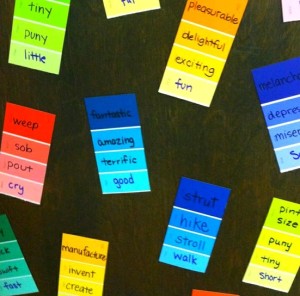Things happen when you’ve return from a conference. New ideas attach with
old ones and a host of “how does  this all connect” is sifted through a lens of “what if…”. At FETC, keynote speaker Michael Wesch (watch TED talk) talked about the fast rise of the new technologies (Youtube 2005; Twitter 2006) resulting in a new culture of belonging/communication, with strong implications for education. With information being so readily available, he offered that education needed to put the “wonder” into the question. And keynote – Heidi Hayes Jacobs (watch TED talk) asked why wouldn’t we combine tools to bring about a deeper infusion of experiences. So my question is how does this connect with the classroom?
this all connect” is sifted through a lens of “what if…”. At FETC, keynote speaker Michael Wesch (watch TED talk) talked about the fast rise of the new technologies (Youtube 2005; Twitter 2006) resulting in a new culture of belonging/communication, with strong implications for education. With information being so readily available, he offered that education needed to put the “wonder” into the question. And keynote – Heidi Hayes Jacobs (watch TED talk) asked why wouldn’t we combine tools to bring about a deeper infusion of experiences. So my question is how does this connect with the classroom?
I’ve been working with a group of teachers on writing process, writers workshop and literature circles and one of the questions we had was how to effectively increase vocabulary in ways that illuminate and explore the power of words to clearly communicate. This is especially important for students who find writing and reading challenging (knowing their vocabulary is incredibly smaller than their peers). Forget the spelling list. Though I’ve used all of the following separately, I’d never thought to combine the tools to gain a deeper connection.
HOW I WOULD USE IT:

Students copy/paste their written text into Wordle or other word cloud generator. The most used vocabulary words will appear larger than the others. Access an online visual thesaurus like Visuwords, Thinkmap Visual Thesaurus, Lexipedia (primary – with audio). Insert the word and watch what happens. Each provide not only a root, definitions, examples but strategic relationships to other words. Choose the appropriate word and replace the ‘worn out word’ in their text. [Use a different colour so it stands out from the other text.] Reread the entire written text several times to hear the relationship of ideas come together. This also helps with integrating the new words into general vocabulary. [As with any tool of this sort, choosing the correct words in context takes thinking practice – some of the words that pop up in online thesauruses may not be appropriate for all age levels.]
 Add these new words to an anchor chart in the classroom so everyone has a ‘visual anchor‘ when writing. Paint chip strips are great for generating word lists. Record the ‘worn out word’ in the top colour box, then add ‘juicy’ words that are connected. When reading, keep a post-it note handy for recording words that ‘pop off the page’ and use these as starting visual anchors. Connect these words with others found in Visuwords. Warning – this activity becomes a bit contagious.
Add these new words to an anchor chart in the classroom so everyone has a ‘visual anchor‘ when writing. Paint chip strips are great for generating word lists. Record the ‘worn out word’ in the top colour box, then add ‘juicy’ words that are connected. When reading, keep a post-it note handy for recording words that ‘pop off the page’ and use these as starting visual anchors. Connect these words with others found in Visuwords. Warning – this activity becomes a bit contagious.
How do you strengthen and extend vocabulary in your writing? I’d be very interested in having you share your ideas here in the comment box.